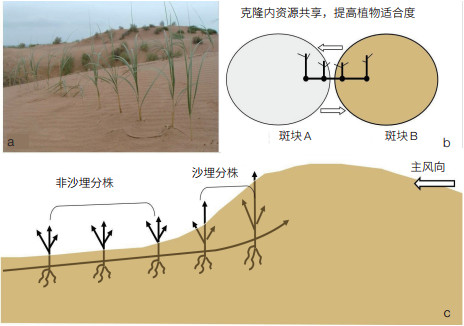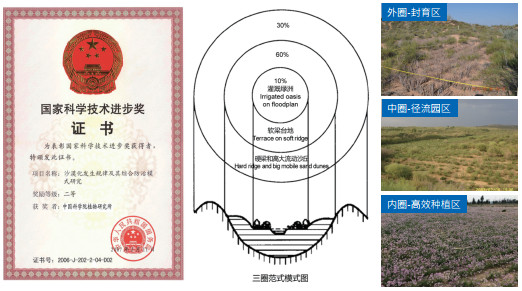2. 鄂尔多斯市林业和草原局 鄂尔多斯 017010
2. Forestry and Grassland Administration, Ordos City, Inner Mongolia Autonomous Region, Ordos 017010, China
沙地泛指草原地带内出现的沙质土地。在我国的半干旱和半湿润地区,广泛分布着沙地,比较典型的有毛乌素、浑善达克、科尔沁和呼伦贝尔等四大沙地,面积约120 000 km2[1]。沙基质是沙地区别于其他生态系统的最主要生态因素。沙基质的不稳定性导致风沙活动频繁、沙地生态系统稳定性较差,在全球变化及人为干扰过程中受到的威胁较大,容易发生不同程度的退化[2]。国内外科学家围绕沙地生态系统退化和恢复开展了大量工作,取得了一定的研究成果。中国科学院鄂尔多斯沙地草地生态研究站(以下简称“鄂尔多斯站”)是最早在我国沙地草地建立的野外站之一,建站的目的是针对当时毛乌素沙地日益严重的荒漠化问题,长期定位监测鄂尔多斯沙地草地生态系统和生态环境变化,开展荒漠化防治研究和试验示范。建站30年来,鄂尔多斯站对沙地草地生态系统的结构和功能及其沙化的过程和机理开展了系统研究,为沙地草地荒漠化治理、受损生态系统恢复和重建、生物多样性保育等提供了重要的理论基础和技术支撑,为以毛乌素沙地为代表的我国退化沙地生态系统的恢复重建与区域可持续发展作出了重要贡献。
1 通过研究植物不同生活史阶段,揭示了沙地植物对环境的多样适应对策针对沙地植物不同生活史阶段对沙地生境的适应策略开展研究,揭示了沙地植物繁殖阶段(产生种子的有性繁殖和克隆分株的无性繁殖)和营养生长阶段对环境的多样适应对策。
(1)种子阶段对环境的适应性研究。植物种子阶段的适应性是植物生态学研究的重要方面。沙地重要植物通过多样的种子生理休眠/萌发机制来适应温带半干旱区的沙基质环境。鄂尔多斯站长期开展植物种子对环境的适应性研究,引领我国种子生态学的发展。鄂尔多斯站围绕种子休眠与萌发、土壤种子库、种子异型性和种子黏液特性开展了一系列深入研究。研究发现了具有生理休眠特性的种子存在季节性休眠循环特性并受到沙埋的调节,为沙地植物种群更新的种子生态学机制提供了新的认识[3];证实了种子黏液可被土壤微生物降解,并通过与土壤微生物之间的相互作用,促进了幼苗建成[4],调控了幼苗出土[5];黏液还通过水合作用阻止动物对种子的采食和传播[6]。种子异型性是一种“两头下注”的适应策略,在母体效应作用下不同异型种子比例在代间有很大变异。一些沙地植物可以通过母体效应产生不同比例的异型种子适应异质性环境[7];植物母体所经历的环境条件对子代表现有显著影响,代间可塑性可为种子异型性植物物种响应环境的时空异质性提供多样化生长和繁殖策略[8]。
(2)植物克隆繁殖对环境的适应性研究。鄂尔多斯站长期开展植物克隆性研究,引领我国克隆植物生态学的发展。克隆植物在沙地生态系统中居优势地位。研究发现一些重要的沙地植物通过克隆整合、克隆储存和克隆扩展等特性适应沙地生境异质性,克隆植物沙埋分株忍受沙埋的能力因克隆整合作用的存在而显著加强,从而增强了植物对沙丘运动的生态适应性[9](图 1),克隆性状能通过影响植物群落组成、结构和动态,进而影响沙地生态系统功能[10]。

|
| 图 1 克隆整合有助于沙鞭耐受沙埋干扰 Figure 1 Clonal integration helps Psammochloa villosa tolerate sand burial disturbance (a)沙鞭在流动沙丘上克隆生长;(b)克隆整合提高植物适合度的机理;(c)克隆内资源共享提高了沙埋分株的存活率 (a) Clonal growth of Psammochloa villosa on moving sand dunes; (b) mechanism of clonal integration to improve plant fitness; (c) intraclonal sharing of resources improves the survival rate of sand buried ramets |
(3)沙地灌木营养生长阶段对环境的适应性研究。频繁的风沙活动是半干旱区沙地的最主要环境特征之一。鄂尔多斯站开展了沙地植物应对强风和风沙活动的适应策略及沙地植被稳定性维持机制方面的研究,发现沙埋条件下灌木茎的机械稳定性相关性状的变化在种内是一致的[11];油蒿灌丛在沙丘半固定阶段通过有效的更新实现种群快速扩张,而在沙丘固定阶段后期则通过植株萎缩来维持种群大小[12];一些沙地优势植物植株大小相关性状对风因子产生相似的响应,而茎部性状对风因子的响应则具有种间特异性,说明植物应对风因子胁迫过程中产生不同性状间的平衡策略[13]。
2 开展不同空间尺度植物适应与响应研究,阐明了植物性状间耦合关系与生物多样性变化规律在样带尺度、区域尺度和全球尺度上,鄂尔多斯站对地上/下植物性状协同变异和生物多样性开展研究,揭示了植物性状、生物多样性和生态系统功能的地理分布格局。
(1)在干旱/半干旱区样带尺度上:叶和根经济学性状在不同的生态学尺度上均存在耦合关系,提高了植物对资源的利用能力,拓展了植物经济型谱理论[14];跨干旱/半干旱区的两条降水样带研究证实了优势植物种沿水分梯度上的地上/下碳氮库的解耦合,是植物对旱区环境的一种适应策略[15];在北方半干旱区草原地上/下生物多样性关系的研究中,发现植物多样性与土壤真菌多样性存在较强的耦合关系,土壤真菌多样性有助于退化草原生态系统的生物多样性恢复[16]。
(2)在区域尺度上:北方重要的植物类群蒿属植物不同物种化学计量学特征对区域环境梯度有不同的响应,物种效应解释了化学元素含量及化学计量特征中最大的变异,证实了即使亲缘关系近的物种在响应环境变化上也存在差异[17-19];蒿属植物叶、茎和根之间都存在很强的异速生长关系,揭示了蒿属植物对半干旱区气候与土壤梯度变化的适应机制[20]。
(3)在全球尺度上:土壤种子库对于维持地上植被多样性具有重要作用。鄂尔多斯站建立了全球土壤种子库数据库,发现了全球尺度上土壤种子库具有明显的空间格局(图 2)。植物多样性较高的低纬度地区的土壤种子库密度较低,在受自然或人为干扰后的复原力更差。揭示了土壤种子库的全球分布格局及其环境驱动因素,为全球生物多样性的保护与恢复提供了新的视角[21]。全球土壤种子库分布格局的研究结果于2021年发表在Nature Communications。

|
| 图 2 全球尺度土壤种子库具有明显的空间格局 Figure 2 The global soil seed bank has obvious spatial pattern (a)每平方分米的物种数量;(b)每平方米种子数量;其中图b数据经过log10转换 (a) Diversity in terms of number of species per 0.01 m2; (b) density as number of seeds per m2; In figure b, values are log10-transformed to facilitate viewing |
通过研究沙埋、光因子、降水等非生物因子和微生物等生物因子在物质循环、碳储量、生态系统生产力的相对作用,鄂尔多斯站研究人员揭示了沙地生态系统结构与功能的关键调控因子。
(1)在沙地生态系统结构方面:阐明了种子萌发生物学相关的功能性状在干旱区植物种群和群落动态中、在物种共存和物种多样性维持中起到的重要作用[22];维持沙地生态系统放牧的可持续性需要优先选择耐干旱、耐啃食的灌木饲料物种[23];种植灌木比种植草本更有利于沙地草地荒漠化防治,并且能够极大地提高沙地草地的碳储量[24]。
(2)在沙地生态系统功能方面:植物凋落物分解是沙地生态系统碳和营养周转的重要环节。光分解是影响沙地生态系统叶凋落物碳氮矿化过程的重要因素[25](图 3);叶表面性状与化学性状对沙地生态系统凋落物分解速率有着不同的影响,为全球碳循环模型的完善提供了新的思路[26]。沙埋通过改变土壤微生物的丰度和组成极大地促进了沙地木质残体的分解[27];沙埋显著影响了沙地植被净地上初级生产力,改变了生态系统碳储量在土壤中的垂直分布[28, 29]。

|
| 图 3 不同梯度光分解受控实验揭示沙地植物凋落物降解过程和调控机制 Figure 3 Controlled experiment of photodegradation with different gradients reveal degradation process and regulation mechanism of plant litter in sandland |
自20世纪80年代以来,由于人类活动和全球变化的共同影响,毛乌素沙地荒漠化趋势日益严重,成为我国北方沙尘暴的主要来源地,给我国北方特别是京津及华北地区生态安全和区域经济的持续发展造成巨大威胁。为了应对日益严重的荒漠化,自20世纪90年代起,鄂尔多斯站以张新时院士为代表的科研人员对毛乌素沙地开展了长期调查研究[30]。在充分研究鄂尔多斯高原生态环境特点,特别是水分平衡特征和景观多样性的基础上,提出了4项鄂尔多斯高原生态-生产范式建造及植被恢复重建的生态原则,即以水为核心、生物气候条件为基础的生态规划原则,以灌木为主、丰富生物多样性原则,以防护林体系特定结构、配置的原则,以半固定沙地和综合治理原则,以此创建了鄂尔多斯高原荒漠化土地可持续治理的优化生态-生产范式(即“三圈”范式①)并进行了试验示范,建立“三圈”范式概念下的荒漠化防治综合技术示范地10 000亩,取得非常好的示范效果[31-33]。
① 三圈:外圈为封育区,中圈为径流园区,内圈为高效种植区
鄂尔多斯高原“三圈”范式的成功经验被广泛应用到其他生态区域,如天山北部山地—绿洲—过渡带—荒漠系统的生态建设与可持续农业范式、内蒙古锡林郭勒的“三带”模式、华北山间盆地生态-生产范式,以及黄土高原丘陵沟壑区小流域优化生态-生产范式等,充实了边际生态系统管理的理论与实践;同时“三圈”范式在空间尺度上扩大,形成了我国大尺度的荒漠化防护圈(即“大三圈”)范式,主要由荒漠、草原和农牧交错带3部分组成,是从全国尺度上安排、解决土地沙化、沙尘暴和生态-生产建设的宏观格局。
鄂尔多斯站已成为利用高新技术防治荒漠化的试验示范基地,先后承担了联合国开发计划署(UNDP)项目、科学技术部“973”项目和科技支撑计划项目,以及国家自然科学基金委员会、中国科学院等与荒漠化防治相关的项目或课题20余项。以鄂尔多斯站为基地开展并以“三圈”范式为核心内容的《沙漠化发生规律及其综合防治模式规律研究》,荣获2006年国家科学技术进步奖二等奖(图 4)。

|
| 图 4 鄂尔多斯站荒漠化综合治理“三圈”范式 Figure 4 "Three circles" paradigm of comprehensive desertification control in Ordos Ecological Station |
30年来,鄂尔多斯站围绕国家生态建设的重大科技需求开展长期生态学研究和示范工作,为沙地草地荒漠化治理、受损生态系统的生态恢复和重建、生物多样性保育等提供了重要的理论基础和技术支撑,为区域可持续发展作出了重要贡献。自1991年建站以来,鄂尔多斯站承担国家自然科学基金委重大项目、原国家科委攻关项目、科学技术部“973”项目、科技支撑计划、国家重点研发计划项目、中国科学院战略性先导科技专项等项目及课题131项,发表论文546篇,其中SCI论文317篇,培养博硕研究生130余名,在国内外产生了重要的影响。
未来,鄂尔多斯站将在沙地生态系统及环境要素的变化规律、沙地生态系统适应性技术与管理,以及生态系统对全球气候变化和人类干扰(如矿山开采)的响应等方面继续积累数据,开展长期生态学观测、研究与试验示范,挖掘沙地生态系统长期演变规律及其对全球变化的响应机制,提升野外观测数据的质量及其对外服务和共享,以期成为我国北方半干旱区沙地草地生态系统长期生态学观测与研究的高水平开放平台,进一步为我国退化沙地生态系统的恢复重建和高质量发展作出积极贡献。
| [1] |
董鸣, 叶学华, 刘国方, 等. 沙地生态系统保护与恢复//李文华. 中国当代生态学研究-生态系统恢复卷. 北京: 科学出版社, 2013: 60-75. Dong M, Ye X H, Liu G F, et al. Protection and restoration of sandy land ecosystem//Li W H. Contemporary Ecological Research in China-Ecosystem Restoration Volume. Beijing: Science Press, 2013: 60-75. (in Chinese) |
| [2] |
黄振英, 叶学华, 朱雅娟, 等. 沙地生态系统的适应性技术与示范//吕宪国, 常亮, 董鸣, 等. 典型脆弱生态系统的适应技术体系研究. 北京: 科学出版社, 2016: 69-129. Hung Z Y, Ye X H, Zhu Y J, et al. Adaptive technology and demonstration of sandy land ecosystem//Lv X G, Chang L, Dong M, et al. Study on Adaptive Technology System of Typical Fragile Ecosystem. Beijing: Science Press, 2016: 69- 129. (in Chinese) |
| [3] |
Ye X H, Li L L, Baskin C C, et al. Sand burial helps regulate timing of seed germination of a dominant herb in an inland dune ecosystem with a semiarid temperate climate. Science of the Total Environment, 2019, 680: 44-50. DOI:10.1016/j.scitotenv.2019.05.087 |
| [4] |
Yang X J, Baskin C C, Baskin J M, et al. Degradation of seed mucilage by soil microflora promotes early seedling growth of a desert sand dune plant. Plant, Cell & Environment, 2012, 35(5): 872-883. |
| [5] |
Hu D D, Zhang S D, Baskin J M, et al. Seed mucilage interacts with soil microbial community and physiochemical processes to affect seedling emergence on desert sand dunes. Plant, Cell & Environment, 2019, 42(2): 591-605. |
| [6] |
Yang X J, Baskin C C, Baskin J M, et al. Hydrated mucilage reduces post-dispersal seed removal of a sand desert shrub by ants in a semiarid ecosystem. Oecologia, 2013, 173(4): 1451-1458. DOI:10.1007/s00442-013-2735-3 |
| [7] |
Wang Z R, Baskin J M, Baskin C C, et al. Great granny still ruling from the grave: Phenotypical response of plant performance and seed functional traits to salt stress affects multiple generations of a halophyte. Journal of Ecology, 2022, 110(1): 117-128. DOI:10.1111/1365-2745.13789 |
| [8] |
Yang X J, Baskin J M, Baskin C C, et al. More than just a coating: Ecological importance, taxonomic occurrence and phylogenetic relationships of seed coat mucilage. Perspectives in Plant Ecology, Evolution and Systematics, 2012, 14(6): 434-442. DOI:10.1016/j.ppees.2012.09.002 |
| [9] |
Yu F H, Dong M, Krüsi B. Clonal integration helps Psammochloa villosa survive sand burial in an inland dune. New Phytologist, 2004, 162(3): 697-704. DOI:10.1111/j.1469-8137.2004.01073.x |
| [10] |
董鸣. 克隆植物生态学. 北京: 科学出版社, 2011. Dong M. Clonal Plant Ecology. Beijing: Science Press, 2011. (in Chinese) |
| [11] |
Xu L, Huber H, During H J, et al. Intraspecific variation of a desert shrub species in phenotypic plasticity in response to sand burial. New Phytologist, 2013, 199(4): 991-1000. DOI:10.1111/nph.12315 |
| [12] |
Li S L, Yu F H, Werger M J A, et al. Habitat-specific demography across dune fixation stages in a semi-arid sandland: Understanding the expansion, stabilization and decline of a dominant shrub. Journal of Ecology, 2011, 99(2): 610-620. |
| [13] |
Zhang S D, Liu G F, Cui Q G, et al. New field wind manipulation methodology reveals adaptive responses of steppe plants to increased and reduced wind speed. Plant Methods, 2021, 17(1): 5. DOI:10.1186/s13007-020-00705-2 |
| [14] |
Liu G F, Freschet G T, Pan X, et al. Coordinated variation in leaf and root traits across multiple spatial scales in Chinese semi-arid and arid ecosystems. New Phytologist, 2010, 188(2): 543-553. DOI:10.1111/j.1469-8137.2010.03388.x |
| [15] |
Ye X H, Pan X, Cornwell W K, et al. Divergence of aboveand belowground C and N pool within predominant plant species along two precipitation gradients in North China. Biogeosciences, 2015, 12(2): 457-465. DOI:10.5194/bg-12-457-2015 |
| [16] |
Wang C W, Ma L N, Zuo X A, et al. Plant diversity has stronger linkage with soil fungal diversity than with bacterial diversity across grasslands of Northern China. Global Ecology and Biogeography, 2022, 31(5): 886-900. DOI:10.1111/geb.13462 |
| [17] |
Yang X J, Huang Z Y, Zhang K L, et al. C: N: P stoichiometry of Artemisia species and close relatives across Northern China: Unravelling effects of climate, soil and taxonomy. Journal of Ecology, 2015, 103(4): 1020-1031. DOI:10.1111/1365-2745.12409 |
| [18] |
Yang X J, Huang Z Y, Zhang K L, et al. Taxonomic effect on plant base concentrations and stoichiometry at the tips of the phylogeny prevails over environmental effect along a large scale gradient. Oikos, 2017, 126(9): 1241-1249. DOI:10.1111/oik.04129 |
| [19] |
Yang X J, Huang Z Y, Zhang K L, et al. Geographic pattern and effects of climate and taxonomy on nonstructural carbohydrates of Artemisia species and their close relatives across Northern China. Biogeochemistry, 2015, 125(3): 337-348. DOI:10.1007/s10533-015-0128-x |
| [20] |
Liu R, Yang X J, Gao R R, et al. Allometry rather than abiotic drivers explains biomass allocation among leaves, stems and roots of Artemisia across a large environmental gradient in China. Journal of Ecology, 2021, 109(2): 1026-1040. DOI:10.1111/1365-2745.13532 |
| [21] |
Yang X J, Baskin C C, Baskin J M, et al. Global patterns of potential future plant diversity hidden in soil seed banks. Nature Communications, 2021, 12: 7023. DOI:10.1038/s41467-021-27379-1 |
| [22] |
Huang Z Y, Liu S S, Bradford K J, et al. The contribution of germination functional traits to population dynamics of a desert plant community. Ecology, 2016, 97(1): 250-261. DOI:10.1890/15-0744.1 |
| [23] |
Li S L, Yu F H, Werger M J A, et al. Understanding the effects of a new grazing policy: The impact of seasonal grazing on shrub demography in the Inner Mongolian steppe. Journal of Applied Ecology, 2013, 50(6): 1377-1386. DOI:10.1111/1365-2664.12159 |
| [24] |
Ye X H, Tang S L, Cornwell W K, et al. Impact of land-use on carbon storage as dependent on soil texture: Evidence from a desertified dryland using repeated paired sampling design. Journal of Environmental Management, 2015, 150: 489-498. DOI:10.1016/j.jenvman.2014.12.039 |
| [25] |
Erdenebileg E, Ye X H, Wang C W, et al. Positive and negative effects of UV irradiance explain interaction of litter position and UV exposure on litter decomposition and nutrient dynamics in a semi-arid dune ecosystem. Soil Biology and Biochemistry, 2018, 124: 245-254. DOI:10.1016/j.soilbio.2018.06.013 |
| [26] |
Liu G F, Wang L, Jiang L, et al. Specific leaf area predicts dryland litter decomposition via two mechanisms. Journal of Ecology, 2018, 106(1): 218-229. DOI:10.1111/1365-2745.12868 |
| [27] |
Erdenebileg E, Wang C W, Ye X H, et al. Multiple abiotic and biotic drivers of long-term wood decomposition within and among species in the semi-arid inland dunes: A dual role for stem diameter. Functional Ecology, 2020, 34(7): 1472-1484. DOI:10.1111/1365-2435.13559 |
| [28] |
Ye X H, Liu Z L, Zhang S D, et al. Experimental sand burial and precipitation enhancement alter plant and soil carbon allocation in a semi-arid steppe in North China. Science of the Total Environment, 2019, 651: 3099-3106. DOI:10.1016/j.scitotenv.2018.10.208 |
| [29] |
Ye X H, Gao S Q, Du J, et al. Responses of aboveground and belowground net primary productivity to sand burial and enhanced precipitation in a semiarid desertified steppe. Land Degradation & Development, 2021, 32(5): 1951-1960. |
| [30] |
沙地立地分类评价课题组. 毛乌素沙地立地质量的综合评价. 林业科学, 1993, 29(5): 393-400. Subject Group of Sand Site Classification and Evaluation. Comprehensive evaluation of site quality of maowusu sand land. Scientia Silvae Sinicae, 1993, 29(5): 393-400. (in Chinese) |
| [31] |
张新时. 毛乌素沙地的生态背景及其草地建设的原则与优化模式. 植物生态学报, 1994, 18(1): 1-16. Zhang X S. Principles and optimal models for development of Maowusu sandy grassland. Acta Phytoecologica Sinica, 1994, 18(1): 1-16. DOI:10.3321/j.issn:1005-264X.1994.01.008 (in Chinese) |
| [32] |
慈龙骏, 杨晓晖, 张新时. 防治荒漠化的"三圈"生态-生产范式机理及其功能. 生态学报, 2007, 27(4): 1450-1460. Ci L J, Yang X H, Zhang X S. The mechanism and function of "3-Circles"-An eco-productive paradigm for desertification combating in China. Acta Ecologica Sinica, 2007, 27(4): 1450-1460. DOI:10.3321/j.issn:1000-0933.2007.04.024 (in Chinese) |
| [33] |
Tang H P, Zhang X S. Establishment of optimized ecoproductive paradigm in the farming-pastoral zone of Northern China. Acta Botanica Sinica, 2003, 45(10): 1166-1173. |



